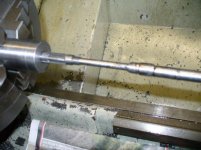homebrew.357
Aluminum
- Joined
- Nov 4, 2013
- Location
- New Zealand
Hi Guys, as you know I`m in to making cut rifle barrels on my lathe, but it`s not all beer and skittles. Having problems with the cutter leaving scratch marks in the bottom of the groves. The cutter tip is made of T/C and trying a back relief with a 90* degree cutting angle so it just scrapes the steel off, with a forward rake of 5* degrees it some times grabs into the steel cutting to deep. I'm getting this with 1045 and 4140 steel, but not to bad with 12L14 steel, and what's the best cutting oil to use, water soluble or straight oil. I see Kruger barrels are lapped after rifling and yes I`m doing that as well. Thanks for any ideas ,Homebrew.357.
 , The cutter bits.
, The cutter bits.
 , The cutter bits.
, The cutter bits.


 . Cheers, Homebrew.357.
. Cheers, Homebrew.357.

